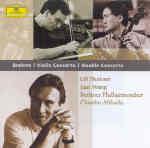I’m going to go out on a limb and call this the finest Brahms concerto since Heifetz/Reiner or Oistrakh/Klemperer (or Szell), and it’s all the more amazing for having been captured live in beautifully balanced, pellucid recorded sound. Actually, Brahms’ concerto has been extremely lucky on disc, not just historically but even recently: witness excellent new recordings by Anne Sophie Mutter and Hilary Hahn, each of which has very special qualities. Still, this newcomer is different–one of those rare occasions (live or not) when everything just goes right, and everyone gives 110 percent in the service of great music.
Before turning to Shaham, a word about Abbado and Berlin, a collaboration widely (and correctly) seen as less than musically successful in general, at least as far as recordings go. And yet, there have been some striking achievements, Abbado’s Brahms being one of them. Though seldom mentioned or acknowledged, his complete symphony cycle with Berlin ranks among the very finest, so it’s no surprise that he offers outstanding accompaniments, drawing a richly Brahmsian sonority built on sturdy bass lines, warm strings, and mellow winds. There’s so much to admire here, but four examples will have to suffice in describing an interpretation that deftly touches in all of the details without ever micro-managing or losing the long line.
First, in measure 64, observe how the tiny hairpin half-note roll in the timpani continues and binds together the principal phrase in the woodwinds–a small matter, but one made meaningful by the results. Next, at the beginning of the slow movement, aside from the lovely principal oboe, pay particular attention to the fruity tone of the bassoons and to the way Abbado turns this introduction into genuine “Feldharmonie”, or wind serenade music such as Haydn or Mozart would have understood. Surely this was Brahms’ point, and how perfectly this reedy sonority sets off Shaham’s entrance! Finally, listen to the huge excitement that Abbado brings to the returns of the principal Rondo theme: no underplaying here. And then there’s the big picture: this must be one of the swiftest performances since Heifetz/Reiner–a touch under 21 minutes for the first movement, eight and a half for the second, and just under seven and half for the third. What a pleasure it is to hear the music’s energy and athleticism emerge in such a wholly musical and technically polished way!
As for Shaham, he offers playing of “Golden Age” caliber. The basically swift tempos permit him to indulge the wildest flights of virtuoso fancy while remaining basically in tempo, and so the need to show off never comes at the price of structural integrity (as in the recent Rattle/Chung on EMI). You can hear this very clearly in the cadenza (Joachim’s), which now seems an integral part of what precedes and follows rather than an independent episode. Shaham’s slightly husky, gutsy timbre suits the music to a tee, and his purity of intonation even in the highest positions is extremely impressive. In the Adagio he really communes with the wind players, correctly refusing to hog the limelight, and then he plays the living daylights out of the finale, treating us to a coda of delicious lightness and a final decrescendo and ritardando as perfectly judged as any you will ever hear. It’s a magnificent effort, and sadly it represents one of this fine artist’s last for DG, a label that he served very well.
After the once-in-a-lifetime thrills of the Violin Concerto, it’s perhaps inevitable that the Double Concerto would represent an achievement on a slightly lower level. Here the problem largely stems from cellist Jian Wang, not perfectly steady of pitch, and more to the point somewhat soft-edged rhythmically speaking. The way he sort of slides into the opening theme of the finale offers an excellent case in point, and since he has the lion’s share of the solo work, the performance suffers accordingly. But then, the need to coordinate two soloists inevitably works against the sort of spontaneous combustion that occurs in the Violin Concerto, and ultimately, with both Shaham and Abbado on form, what we have here is simply the difference between good and truly great. The rating then reflects the Violin Concerto, which alone is more than worth the price of the disc. Do not, on any account, miss this recording.
































